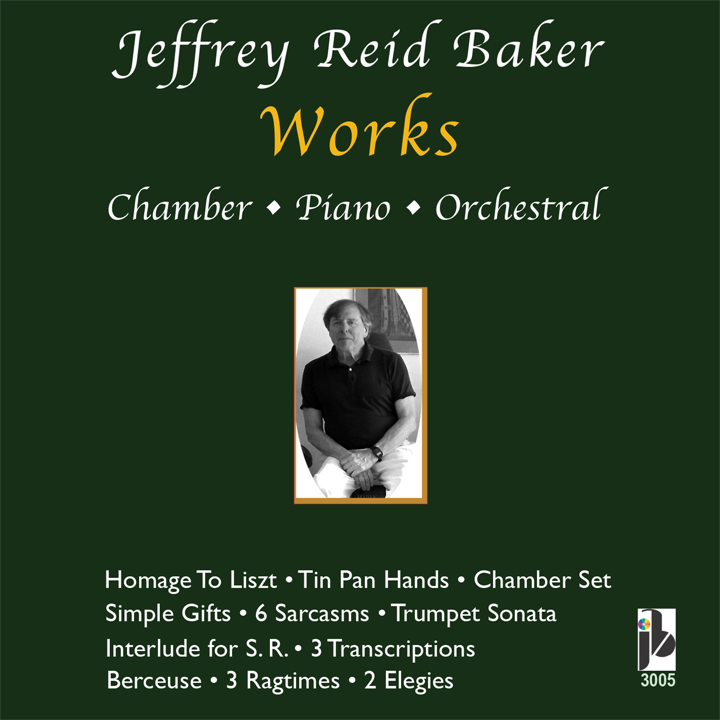
CD


JRB CD-3005
Homage to Liszt Grand Tarantella (1986)
Tin Pan Hands Andante & Stomp (1987)
Chamber Set, Op. 3 (1988)
Berceuse, Op. 6 (1999)
The Two-Step Rag, Op. 7, No. 1 (1974)
The Unicorn Rag, Op. 7, No. 2 (2000)
The Zez Mendelssohn Rag, Op. 7, No. 3 (1992)
Elegies (2) Op. 3 (1997/9)
Clouds 501 (1992)
Waltz for Lia (2017)
Conversation (1990/2020)
Fantasy No.3 (2015)
Simple Gifts: Theme & 3 Variations (2006)
Sarcasms (6) Op. 4 (1988)
Interlude for S. R. Op. 8 (1999)
Sonata For Trumpet (2 Movements) Op.14 (2021)
27 C. P. E. Bach: Solfeggietto arr. 2 Pianos by J. Baker (1996)
28 Bach/Gounod Ave Maria arr. J. Baker (2005)
29 Weiss: Lute Suite Gigue arr. For Left Hand by J. Baker (2018)
Program Notes by Jeffrey Reid Baker
The Homage to Liszt is a grand tarantella for solo piano which I composed for my first album (1986) featuring the music of Franz Liszt. It is a wild romp imitating composers who were themselves inspired by Liszt.
Tin Pan Hands for solo piano was composed for an album I did in 1987 featuring the music of George Gershwin. It is somewhat Gershwin-esque but also pays tribute to the novelty piano styles of the 1920s and 30s.
The Chamber Set was written for an album that never happened. It is scored for two flutes, piano and bass.The movements are quite diverse stylistically.The third movement was originally titled For Nina but somehow it got an “r” on the end and I left it.
The Two-Step Ragtime for piano was actually my first publishable composition and this is its premiere recording. It is subtitled “A Double-Note Sensation” as it features 2 voices in the right hand throughout.
The Unicorn Rag for piano was written for an album I did for the Musicland Group called Scott Joplin's Greatest Hits.
I named my next rag (for piano 3 hands) The Zez Mendelssohn Rag because it has elements of composers Zez Confrey and Felix Mendelssohn. It’s a novelty.
The Two Elegies for large orchestra were composed for the passing of my father (1997) and my grandmother (1999). They are cast as small tone poems and were originally for organ. William’s Song uses a melody written by my father.
Clouds501 was originally written for multi-keyboards. But because students seemed to like it, I made this arrangement for solo piano.
One day, one of my piano students, Lia, asked me "How do you compose music?" I told her that I couldn't tell her but I could show her. The result was the Waltz for Lia.
One night in 1990, I improvised a few ideas on piano while recording into my digital audio workstation. Years later, I listened back to what I had played that night and found one improv which struck me as a complete composition. After some editing, I ended up with a very likeable and well-crafted piece which I titled Conversation.
The Fantasy No. 3 was my attempt to capture the cross- hand technique found in Franz Liszt’s Un Sospiro Etude into a piece playable by the young pianist.
One of my student’s mothers asked if I could teach her son Simple Gifts. I took at it as an opportunity to make something more than that.The result was Simple Gifts: Theme & 3 Variations which my student did learn much to his mother’s delight.
In 1988, I wrote an app called Keys! During the development of the app, I would test it by making up little pieces. The SIx Sarcasms were the results of those tests. I named them Sarcasms because they sounded sarcastic. Prokofiev used this title also.
The Interlude for S. R. For 2 pianos was written for my Rachmaninoff CD as a "light break" between the large Cello Sonata (which I rewrote as a Two-Piano Sonata) and the large Piano Concerto No. 3. It is a variation on a simple Danish song called Sailor's Dance.
The Trumpet Sonata is also the result of an assignment for a student. I wanted to demonstrate a few things, particularly about ‘musical form’, and ended up writing this Sonata! It is dedicated to my father, Dr. William E. Baker, who was quite an extraordinary trumpeter.
The last three selections are special arrangements I have done. When my daughter learned the Solfeggietto of CPE Bach, I wanted to play along with her on a second piano. So, I composed a very romantic second piano part just to add to the party. Both my son’s piano teacher and my piano teacher learned it and had great fun with it.
My arrangement of the Ave Maria by Bach/Gounod came with a self-imposed challenge - to maintain the Bach original 'note for note' while adding the Gounod melody to it. As an added challenge, I tried to hold it to an intermediate piano level.
Recently, my piano teacher from college injured her right hand. It gave me the opportunity to arrange one of my absolute favorite pieces - the Gigue from the Weiss Guitar Suite in A minor - for the left hand. Pure self-indulgence.
©2024 JeRBil, Inc. of New York



